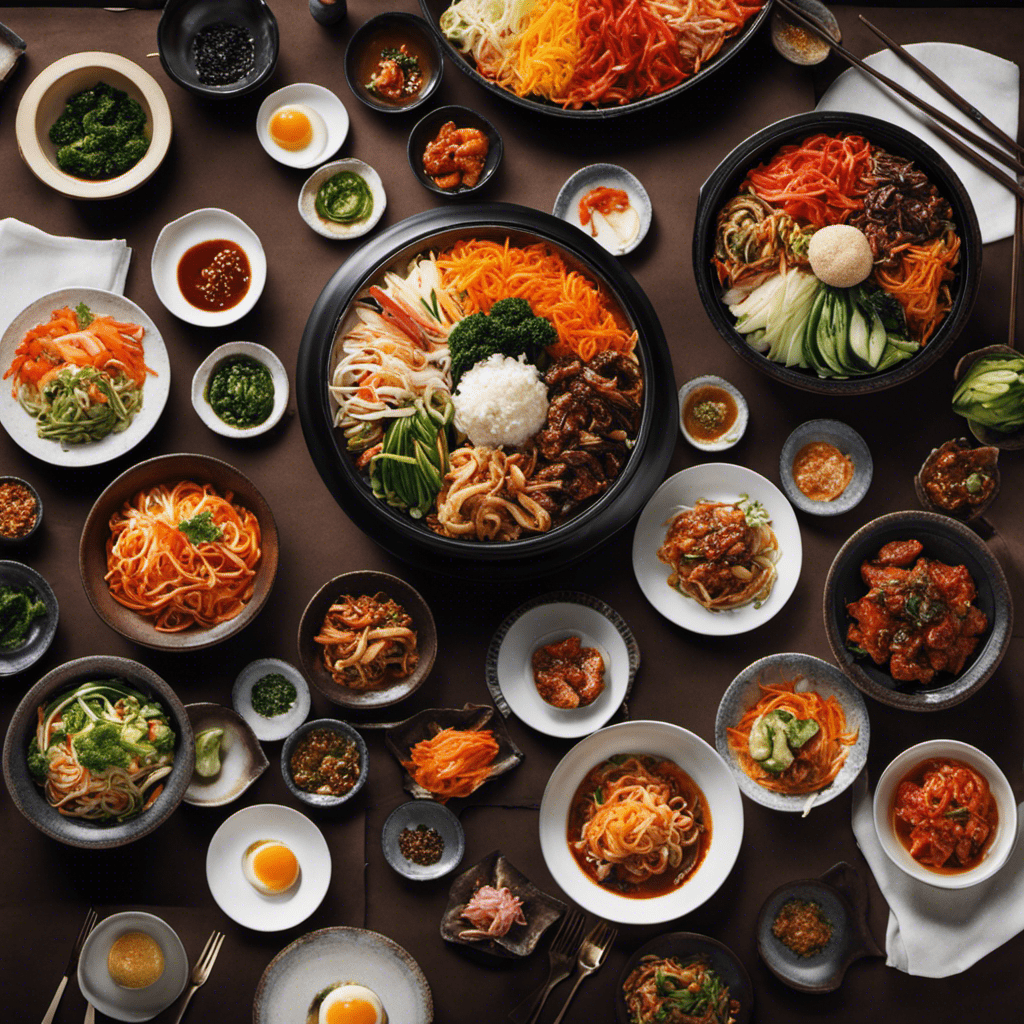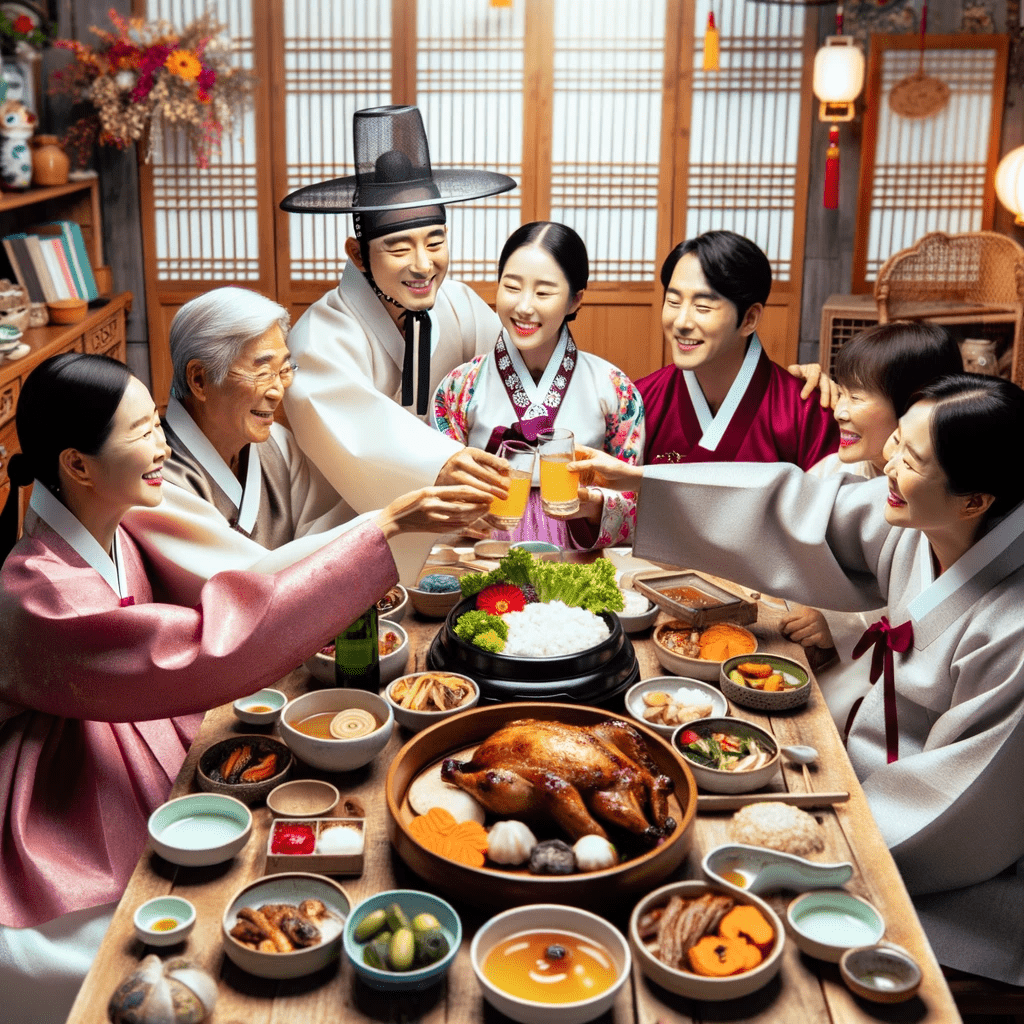Are you ready to embark on a culinary journey where flavors dance on your taste buds and traditions come alive on your plate?
In this article, we invite you to explore the art of eating in South Korea, a country where food is not just sustenance but a vibrant expression of culture.
From historical influences that shaped their cuisine to modern innovations that push boundaries, discover how each bite tells a story and every meal becomes an unforgettable experience.
So grab your chopsticks and prepare for a delicious adventure into the cultural significance of food in South Korea. Let’s dig in!
Key Takeaways
- Food preservation techniques like fermentation, salting, and drying have shaped South Korean cuisine, resulting in dishes like kimchi, ganjang gaejang, and jeotgal.
- Regional ingredients play a significant role in traditional food preparation, reflecting the climate and geography of different regions in South Korea.
- Fusion cuisine combines traditional recipes with new ingredients, showcasing adaptability and creativity in South Korean cuisine.
- South Korean street food offers a variety of popular options such as tteokbokki, kimbap, hotteok, twigim, and bungeoppang, which are enjoyed by locals and tourists alike.
Historical Influences on South Korean Cuisine
The historical influences have greatly shaped South Korean cuisine. One of the most significant influences is the practice of food preservation throughout history. Koreans developed various techniques to preserve food, such as fermenting, salting, and drying. These methods were essential in a country with long winters and limited access to fresh ingredients.
The art of fermentation gave rise to iconic dishes like kimchi. Kimchi is made by pickling vegetables in a spicy brine and allowing them to ferment over time. This process not only preserved food but also enhanced its flavor and nutritional value.
Salting was another common method used for preserving meat and fish. This resulted in dishes like ganjang gaejang (raw crab marinated in soy sauce) or jeotgal (fermented seafood).
The historical emphasis on food preservation continues to be an integral part of South Korean cuisine today, adding depth and complexity to its flavors.
Keywords: influences on Korean cuisine, historical food preservation
Traditional Food Preparation Techniques
In this discussion, you’ll explore the historical food preservation methods and the influence of regional ingredients on traditional food preparation techniques.
These two key points shed light on the rich culinary heritage of different cultures and how they’ve adapted to preserve their food over time.
Historical Food Preservation Methods
Learn about the historical food preservation methods used in South Korea and how they have shaped the culinary traditions of the country. South Korean cuisine is known for its rich flavors and unique cooking techniques, which are heavily influenced by their traditional methods of preserving food.
Fermentation Techniques: Kimchi, a staple in Korean cuisine, is made through the process of lacto-fermentation, where vegetables like cabbage are preserved in a mixture of salt and spices.
Drying Methods: Another popular preservation method is drying. Ingredients such as fish, meat, and vegetables are dried under the sun or using special drying equipment to extend their shelf life.
These preservation methods not only helped Koreans store food during harsh winters but also contributed to the development of distinct flavors that are now synonymous with Korean cuisine.
Influence of Regional Ingredients
Did you know that regional ingredients play a crucial role in shaping the unique flavors of Korean cuisine? The influence of regional flavors is one of the key factors that contribute to the rich and diverse culinary heritage of South Korea.
Each region in Korea has its own distinct ingredients, such as seafood along the coast, fresh vegetables from fertile farmland, and mountain herbs found in the rural areas. These local ingredients not only provide different taste profiles but also reflect the climate and geography of each region.
Furthermore, they have greatly influenced the development of fusion cuisine in Korea. The combination of traditional recipes with new ingredients has led to innovative dishes like bibimbap sushi or kimchi tacos, which blend traditional Korean flavors with international culinary trends.
This dynamic interplay between regional flavors and fusion cuisine showcases the adaptability and creativity of Korean food culture.
Popular South Korean Street Foods
You’ll love the variety of popular South Korean street foods. From savory to sweet, there is something for everyone to enjoy.
Here are some must-try options:
-
Tteokbokki: These spicy rice cakes are a staple of Korean street food. The chewy texture and fiery flavor make them irresistible.
-
Kimbap: Similar to sushi rolls, kimbap features rice, vegetables, and meat wrapped in seaweed. It’s a perfect on-the-go snack.
-
Hotteok: These sweet pancakes are filled with brown sugar syrup and nuts. The warm gooey center makes them a delightful treat.
-
Twigim: This deep-fried dish includes various ingredients like vegetables, seafood, and meat coated in a crispy batter. It’s crunchy goodness at its finest.
-
Bungeoppang: Shaped like a fish, this pastry is filled with sweet red bean paste or custard. It’s both adorable and delicious.
South Korean street food trends have also given rise to fusion dishes that blend traditional flavors with modern twists. So get ready to indulge your taste buds in the vibrant world of South Korean street food!
Rituals and Etiquette Surrounding Korean Dining
When dining in Korea, it’s important to observe the rituals and etiquette that accompany the meal. Korean dining customs are deeply rooted in tradition and play a significant role in their culture.
The table settings are meticulously arranged, with each element serving a specific purpose. Utensil usage is also unique, as chopsticks and spoons are commonly used.
Traditional Korean meals follow a structured format, starting with banchan, which are an assortment of small side dishes that provide a variety of flavors and textures. These banchan dishes complement the main dishes that follow.
The meal is often accompanied by rice or other grains, which serve as the foundation of the meal.
Health Benefits of South Korean Ingredients
When it comes to discussing the nutritional value of ingredients in South Korean cuisine, you will find a wide range of options that are not only delicious but also packed with essential nutrients.
From kimchi, which is rich in probiotics and antioxidants, to seaweed that is loaded with vitamins and minerals, these ingredients play a significant role in promoting overall health and well-being.
Additionally, traditional remedies for ailments are deeply rooted in South Korean culture, with various herbs and natural ingredients being used to treat common health issues such as digestive problems, colds, and fatigue.
Nutritional Value of Ingredients
The nutritional value of ingredients is often a key consideration when preparing South Korean dishes. South Korea’s culinary traditions place great importance on using fresh, nutrient-rich ingredients to create flavorful and healthy meals.
Here are some examples of ingredients that are commonly used in South Korean cuisine and their nutritional benefits:
-
Kimchi: This fermented cabbage dish is not only delicious but also packed with vitamins A, B, and C, as well as probiotics that support gut health.
-
Seaweed: Rich in iodine and minerals like calcium, iron, and magnesium, seaweed is a staple ingredient in many Korean dishes.
-
Ginseng: Known for its medicinal properties, ginseng is commonly used in soups and teas to boost energy levels and improve cognitive function.
-
Soybean paste (Doenjang): Made from fermented soybeans, this savory paste provides essential amino acids, vitamins, and minerals.
-
Garlic: Besides adding flavor to dishes, garlic has antibacterial properties and contains compounds that may help lower cholesterol levels.
These ingredients not only contribute to the unique flavors of South Korean cuisine but also provide numerous health benefits. Incorporating them into your diet can be a delicious way to nourish your body while exploring the cultural significance of South Korean food.
Traditional Remedies for Ailments
Using traditional remedies is a common practice in South Korea for treating various ailments and promoting overall well-being. The cultural practices surrounding these remedies reflect the deep-rooted belief in the power of natural ingredients to heal the body. In fact, many traditional remedies have been passed down through generations, with each family having their own secret concoctions. These remedies often utilize common ingredients found in Korean cuisine, such as ginger, garlic, ginseng, and red dates. Take for example the popular remedy known as yuja tea, which combines yuja fruit with honey and hot water. This citrus-infused drink is believed to boost immunity and relieve cold symptoms. Another commonly used remedy is samgyetang, a chicken soup infused with medicinal herbs like ginseng and jujube. Not only does it taste delicious but it also provides nourishment and helps strengthen the body’s immune system. So next time you’re feeling under the weather or just want to maintain your health, why not give these traditional remedies a try? Your taste buds will thank you!
| Traditional Remedy | Ingredients |
|---|---|
| Yuja Tea | Yuja fruit, honey, hot water |
| Samgyetang | Chicken, ginseng root, jujube |
The Role of Food in Korean Festivals and Celebrations
During Korean festivals and celebrations, you’ll experience the role of food in a truly immersive way. Food plays a significant role in these events, showcasing both the cultural significance and traditional food symbolism of South Korea. Here are five ways in which food takes center stage during these festive occasions:
-
Banquet feasts: Delight in lavish spreads that feature an array of dishes, representing abundance and prosperity.
-
Rice cakes: Indulge in various types of rice cakes such as tteok and songpyeon, symbolizing longevity and good fortune.
-
Alcohol: Savor traditional rice wine or soju to toast to health, happiness, and unity among family and friends. Enjoy makgeolli, a milky rice wine known for its refreshing taste and association with fertility.
The meticulous preparation of these dishes showcases the care and attention given to every aspect of Korean festivals. So next time you attend one, make sure to indulge yourself in this culinary celebration!
Modern Innovations in South Korean Gastronomy
Innovations in South Korean gastronomy have brought new flavors and techniques to traditional dishes. The art of cooking has evolved with the introduction of modern culinary techniques, resulting in a vibrant fusion cuisine that showcases the creativity and adaptability of Korean chefs.
One example of this innovation is the table below, which highlights some unique fusion dishes that have emerged from South Korea’s dynamic food scene:
| Dish | Description |
|---|---|
| Kimchi Pizza | A delicious combination of spicy kimchi and gooey cheese |
| Bibimbap Sushi Roll | A sushi roll filled with colorful vegetables and savory rice |
| Tteokbokki Burger | A burger patty made from chewy rice cakes, topped with spicy sauce |
| Gochujang Pasta | Spaghetti tossed in a fiery gochujang sauce |
| Bulgogi Tacos | Soft tortillas filled with marinated beef and fresh toppings |
These innovative creations not only satisfy the taste buds but also showcase South Korea’s ability to blend tradition with modernity. By embracing new techniques and experimenting with ingredients, Korean gastronomy continues to evolve, surprising and delighting food enthusiasts around the world.
Frequently Asked Questions
What Are Some Common Ingredients Used in South Korean Cuisine?
You’ll find a treasure trove of traditional Korean ingredients in their cuisine. From spicy gochujang to savory doenjang, these flavors bring life to popular dishes like bibimbap and kimchi jjigae.
How Has South Korean Cuisine Been Influenced by Other Cultures?
South Korean cuisine has been heavily influenced by other cultures, resulting in a unique fusion of flavors. From Chinese and Japanese influences to Western fast food, the culinary landscape of South Korea is rich and diverse.
What Are Some Unique Traditional Food Preparation Techniques in South Korea?
In South Korea, traditional food preparation techniques are deeply rooted in the culture. From salted and fermented vegetables to kimchi, these preservation methods not only enhance flavors but also play a vital role in Korean cuisine’s rich history.
How Does Street Food Culture Contribute to the Overall Culinary Experience in South Korea?
Street food culture in South Korea greatly enhances the culinary experience. The impact of street food vendors can be seen in the diverse and delicious offerings they provide. Additionally, the popularity of street food festivals adds an exciting and vibrant element to the overall food scene.
Are There Any Specific Rules or Customs to Follow When Dining in a Korean Restaurant?
When dining in a Korean restaurant, it’s essential to know the rules and customs of Korean dining etiquette. From removing your shoes to using chopsticks properly, these table manners add flavor to your culinary experience.
Conclusion
In conclusion, South Korean cuisine holds a rich cultural significance that goes beyond mere sustenance.
From its historical influences and traditional preparation techniques to the popular street foods and dining rituals, every aspect of Korean food reflects the nation’s unique identity.
Moreover, the health benefits of South Korean ingredients cannot be overlooked.
As you delve into this fascinating culinary world, ask yourself: How does food connect us to our heritage and shape our cultural identities?





0 Comments